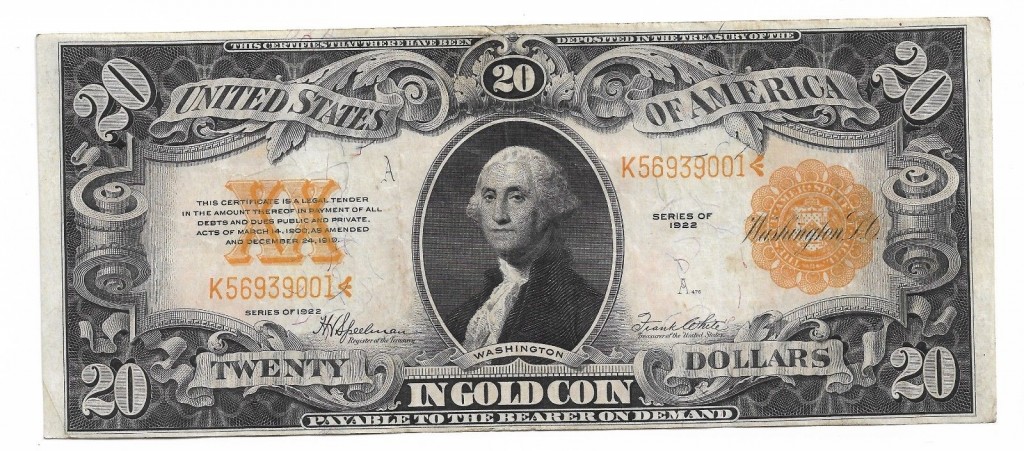A gold certificate in general is a certificate of ownership that gold owners hold instead of storing the actual gold.
It has both a historic meaning as a U.S. paper currency (1863–1933) and a current meaning as a way to invest in gold.
Banks may issue gold certificates for gold that is allocated (non-fungible) or unallocated (fungible or pooled). Unallocated gold certificates are a form of fractional-reserve banking and do not guarantee an equal exchange for metal in the event of a run on the issuing bank’s gold on deposit. Allocated gold certificates should be correlated with specific numbered bars, although it is difficult to determine whether a bank is improperly allocating a single bar to more than one party.
We buy and sell coins, paper money, estate jewelry, platinum, stamps, diamonds, all forms of gold / silver, and more. We accept walk-ins and appointments
CONTACT US NOW
$20 Gold Certificate
United States Gold Certificates were a form of currency that were issued by the United States government between the late 1800s and the mid-1900s. These certificates were backed by gold reserves held by the US Treasury and were redeemable for gold or gold coins at the time of issuance.
The history of United States Gold Certificates can be traced back to the Civil War, when the federal government began issuing paper money to help finance the war effort. At the time, the US was on the gold standard, which meant that paper currency was backed by gold reserves held by the Treasury. However, as the war dragged on, the demand for paper money outstripped the supply of gold, leading to inflation and devaluing the currency.
To combat this problem, the government began issuing Gold Certificates, which were backed by gold reserves held by the Treasury. The first Gold Certificates were issued in 1863 and were available in denominations ranging from $10 to $10,000. These certificates were redeemable for gold coins of equivalent value, which helped stabilize the currency and restore confidence in the US monetary system.
Over time, the design of the Gold Certificates changed, with different denominations featuring different designs and portraits of famous Americans. Some of the most famous designs included the $20 bill featuring a portrait of President Andrew Jackson and the $100 bill featuring a portrait of Benjamin Franklin.
In 1933, President Franklin D. Roosevelt signed an executive order that prohibited the hoarding of gold and required all Gold Certificates to be surrendered to the Treasury. This was part of a larger effort to stabilize the US economy during the Great Depression. However, not all Gold Certificates were surrendered, and some are still in circulation today.
Today, Gold Certificates are no longer in circulation as a form of currency, and their value is based on their collectible value and rarity. Some collectors prize Gold Certificates as historical artifacts and examples of early US currency design.
Gold Certificates played an important role in the history of US currency and helped stabilize the economy during times of inflation and uncertainty. While they are no longer in circulation, their legacy lives on as valuable and collectible artifacts of US monetary history.
